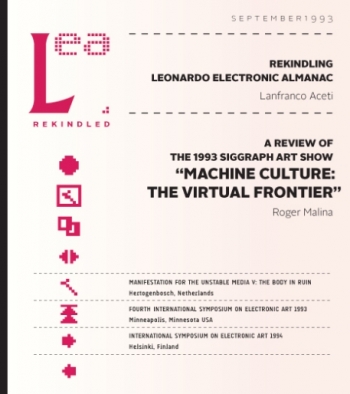
Introducing LEA rekindled
With the re-launch of the Leonardo Electronic Almanac (LEA) we inherited a rich historical collection of writings and thematic issues that spans twenty years.
Historical collections, particularly historical collections of digital media hosted over the Internet, have had a tendency to disappear with the closure of a server or to be left abandoned on a database hosted on the hard drive of a dusty computer in the department of a university. The editorial choice for LEA was not simply that of re-presenting the same material, but to propose to the academic, artistic and scientific communities to re-engage with issues and themes 20 years later. The idea is to develop new discourses, re-attempt to put to rest old diatribes and to engage with the developments in the field of the interactions between art, science and technology.
The editorial choice I made was to collect the old material and make it available on Kindle, remediating the old format and rekindling old arguments and passions by finalizing arguments that appear to no longer have relevance and by breathing new life in to historical subject areas that are still relevant today, picking up from the threads left by the pioneers and commentators of the recent past.
LEA rekindled 1 is the first historical comparative issue of the Leonardo Electronic Almanac on the history and contemporary developments at the intersection of art, science and technology. For this first issue LEA’s editorial intention is to get back in touch with those who participated in building the history of contemporary art interactions with science and technology as well as with the new generations of artists, critical commentators, scientists and technology experts.
In A Review of the 1993 SIGGRAPH Art Show “Machine Culture: The Virtual Frontier” Roger Malina in the first issue of LEA wrote: “It is my personal belief that contemporary art can be most effective when it takes into account the new knowledge that contemporary science brings to bear on our understanding of ourselves and the world around us, and makes use of appropriate new tools for art making – tools that enhance artistic expression given the media saturated context of today. Contemporary art speaks to people of today, effective contemporary art uses appropriate new developments in the culture of today. In some sense contemporary art, at its best, could not have been made in the past.”
For the first issue of LEA rekindled we are looking at essays, both contemporary and historical, as well as commentaries and reviews, that engage – even in a polemical manner – with the rooting of contemporary art in the context of art and science and its larger sociological and cultural implications. The new essays will be placed against, face to face, old commentaries, articles, reviews and announcements of exhibitions and conferences, thereby creating a comparative framework between past and present.
We are also asking to the community at large to consider these issues not only as an academic publication outlet but also as a repository for images and documentation (photographic, audio and video). If you have images from some of the art, science and technology events of the past 20 years that you would like to contribute for publication, please do get in touch with LEA staff by sending an email to info@leoalmanac.org with the subject LEA rekindled. We look forward to the opportunity of working with you in re-contextualizing and publishing in stable formats these artworks.
LEA rekindled will offer the opportunity to compare the historical and the contemporary, the historical predictions with the current developments in art, science and technology as well as re-imagining future scenarios.
LEA rekindled will also be available on iPAD, where readers will be able to contribute with their own annotations and comments.
Below is a PDF showing how LEA rekindled will look, with the old and new content juxtaposed in a newly re-contextualized framework.
As always the Leonardo Electronic Almanac looks forward to working with the academic, artistic and scientific communities.
Lanfranco Aceti
Editor-in-Chief
Posted by: Ozden Sahin (LEA Co-editor and Curator)

